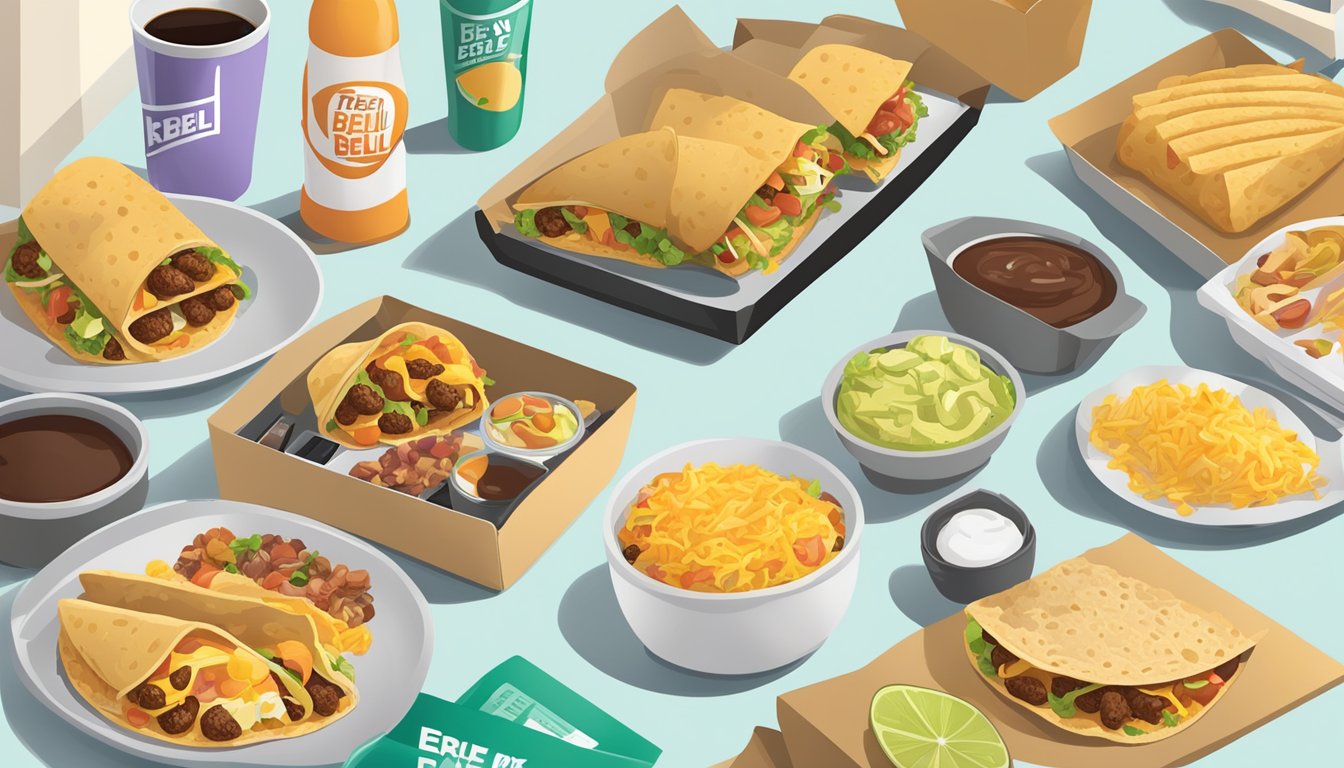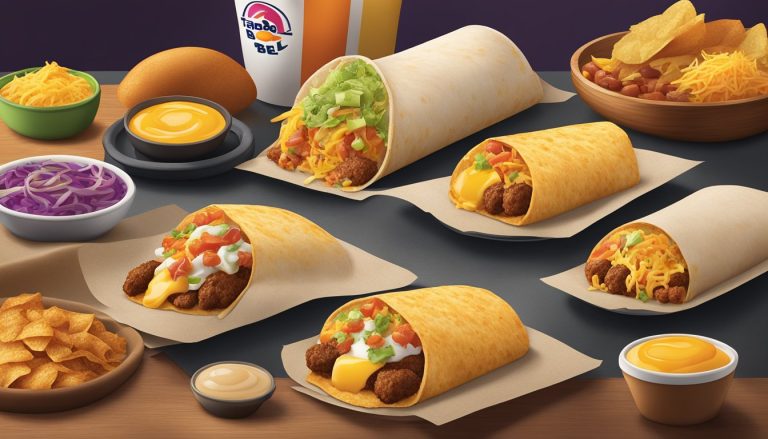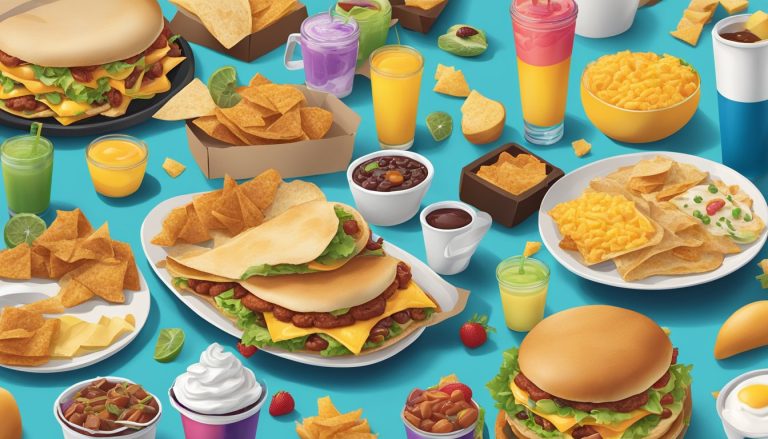Taco Bell’s breakfast menu offers a range of options for those seeking a quick morning meal. From breakfast burritos to tacos and quesadillas, the fast-food chain provides various choices to start the day. While Taco Bell’s breakfast items can be convenient, many are high in calories, fat, and sodium, making them less suitable for those prioritizing nutritional value in their diet.
The nutritional content of Taco Bell’s breakfast items varies significantly. Some options, like the Potato Breakfast Taco, contain fewer calories at 220, while others, such as the Grande Toasted Breakfast Burrito with sausage, pack a hefty 730 calories and 47 grams of fat. Understanding these differences can help customers make more informed choices.
Taco Bell offers customization options that allow patrons to modify their breakfast orders for potentially healthier outcomes. Removing certain ingredients or opting for lighter alternatives can reduce calorie, fat, and sodium content. By examining the nutrition facts provided by Taco Bell, customers can tailor their choices to better align with their dietary goals.
Overview of Taco Bell’s Breakfast Menu

Taco Bell’s breakfast menu offers a variety of options, from burritos and tacos to unique creations like the Breakfast Crunchwrap. The menu balances classic breakfast flavors with Taco Bell’s signature Tex-Mex twist.
Breakfast Burritos
Taco Bell’s breakfast burritos come in several varieties. The bacon and egg burrito contains 450 calories and 196 mg of cholesterol. Other options may include sausage or steak as protein choices.
These burritos typically feature scrambled eggs, cheese, and a protein wrapped in a soft tortilla. Some versions include hash browns for added texture and flavor.
Calorie counts for breakfast burritos generally range from 350-500 calories, depending on the specific ingredients. Customers can customize their burritos to suit their preferences or dietary needs.
Breakfast Crunchwrap
The Breakfast Crunchwrap is a unique Taco Bell creation. It features a hexagonal-shaped tortilla filled with breakfast ingredients and grilled to create a crispy exterior.
Typical ingredients include scrambled eggs, cheese, a hash brown, and choice of bacon, sausage, or steak. The Crunchwrap is then folded and grilled to seal in the contents.
This item tends to be higher in calories compared to other breakfast options, often ranging from 600-700 calories. It provides a substantial meal for those seeking a hearty breakfast on-the-go.
Cinnabon Delights and Coffee
Taco Bell offers Cinnabon Delights as a sweet breakfast option. These are bite-sized pastries filled with cream and coated with cinnamon sugar.
Cinnabon Delights are sold in packs of 2, 4, or 12. A 2-pack typically contains around 160 calories.
For beverages, Taco Bell serves coffee to complement its breakfast items. They also offer orange juice and a specialty drink called Mountain Dew AM.
Breakfast Tacos
Taco Bell’s breakfast tacos are a lighter option on the menu. The Potato Breakfast Taco contains 220 calories, while the Sausage Breakfast Taco has 230 calories.
These tacos feature a soft tortilla filled with eggs, cheese, and a choice of potato, bacon, or sausage. They provide a handheld breakfast option that’s easy to eat on-the-go.
Breakfast tacos at Taco Bell contain common allergens such as egg, gluten, milk, and wheat. They do not contain fish, MSG, peanuts, sesame, shellfish, soy, or tree nuts.
Nutritional Breakdown of Popular Breakfast Items

Taco Bell’s breakfast menu offers a variety of options with differing nutritional profiles. Key factors include calorie content, macronutrient balance, and micronutrient levels.
Calorie Content and Distribution
The Potato Breakfast Taco contains 220 calories, making it one of the lower-calorie options. In contrast, the Sausage Breakfast Taco has 230 calories.
Breakfast quesadillas tend to be higher in calories due to their cheese content. Removing bacon from these items can reduce calorie count by approximately 60 calories.
For those seeking a more substantial meal, the breakfast burritos typically range from 350-500 calories, depending on the specific ingredients.
Macronutrient Profiles
Protein content varies across menu items. The Soft Grilled Chicken Taco Fresco Style provides 11g of protein with only 3.5g of fat and 16g of carbohydrates.
Breakfast tacos generally contain 10-15g of protein. Items with eggs or meat tend to have higher protein levels.
Carbohydrate content is often significant due to tortillas and potatoes. Most breakfast items contain 20-40g of carbs.
Fat content can be high in cheese-heavy items. The Power Bowl (without rice or beans) contains 14g of fat.
Vitamins and Minerals
Sodium levels are a concern in many fast food items. Taco Bell’s breakfast menu is no exception, with most items containing 500-1000mg of sodium.
Calcium is present in items containing cheese or dairy products. Egg-based dishes provide some vitamin A and B vitamins.
Iron content is moderate in meat-based items. Vegetable additions like tomatoes or peppers can boost vitamin C levels.
Potassium can be found in potato-based items and some meat options. Fiber content is generally low but can be increased by adding vegetables.
Assessing Health Considerations

Taco Bell’s breakfast menu offers options that can align with various health goals. Customization, caloric awareness, and sodium content play key roles in making nutritious choices.
Customization for Dietary Restrictions
Taco Bell allows for menu modifications to accommodate dietary needs. Vegetarians can opt for potato-based items or request bean substitutions. Those seeking lower-fat options can ask for reduced cheese or sauces.
For gluten-sensitive individuals, corn tortillas are available as alternatives to flour-based products. Dairy-free choices include items without cheese or creamy sauces.
Calorie-conscious customers can request “fresco style” preparations, which replace cheese, sour cream, and mayo-based sauces with fresh pico de gallo.
Understanding Caloric and Macronutrient Needs
Taco Bell’s breakfast items vary in caloric content. The Potato Breakfast Taco contains 220 calories, while the Sausage Breakfast Taco has 230 calories.
Protein content differs among options. Egg-based items provide a protein boost, essential for muscle maintenance and satiety.
Carbohydrate levels fluctuate based on tortilla size and fillings. Whole grains are limited, with most carbs coming from refined sources.
Fat content varies. Items with cheese or meat typically have higher fat levels. Selecting leaner proteins or reducing cheese can lower fat intake.
Sodium and Heart Health
Sodium levels in Taco Bell’s breakfast items can be high. Regular consumption may contribute to elevated blood pressure in sensitive individuals.
To reduce sodium intake:
- Choose items with fewer ingredients
- Request less cheese or sauce
- Opt for fresh vegetables as toppings
Balancing Taco Bell breakfast choices with lower-sodium meals throughout the day can help maintain heart health. Pairing menu items with fresh fruits or vegetables can increase nutrient density and fiber content.
Ingredients and Quality Standards

Taco Bell emphasizes using quality ingredients and offering transparency about their sourcing practices. The chain also provides options for vegetarian customers and has obtained certifications for certain menu items.
Sourcing and Ingredient Transparency
Taco Bell sources ingredients from various suppliers to create their menu items. The company states they use real cheddar cheese, fresh produce, and seasoned beef in their offerings.
Their website provides detailed nutrition facts and ingredient lists for all menu items, including breakfast options. This allows customers to make informed choices about their meals.
Taco Bell has committed to removing artificial colors and flavors from their core menu items. They’ve also pledged to reduce sodium content across their menu.
Vegetarian Options and Certifications
Taco Bell offers several vegetarian-friendly breakfast options. These include items like the Potato Breakfast Taco, which contains 220 calories.
The American Vegetarian Association has certified some of Taco Bell’s vegetarian menu items. This certification ensures these options meet specific vegetarian standards.
Taco Bell uses a variety of vegetables in their breakfast menu, including potatoes, tomatoes, and onions. These ingredients add nutritional value and bold flavors to their morning offerings.
Customers can customize many breakfast items to be vegetarian by substituting beans for meat proteins.
Taco Bell’s Position and Best Practices in Fast Food

Taco Bell has established itself as an innovative leader in the fast food industry, particularly in the breakfast segment. The company also demonstrates a commitment to sustainability and community engagement through various initiatives.
Innovative Breakfast Choices
Taco Bell’s breakfast menu revolutionized the QSR landscape with unique offerings like the Breakfast Crunchwrap and Cinnabon Delights. These items blend traditional breakfast ingredients with Taco Bell’s signature Mexican-inspired flavors. The chain introduced all-day breakfast at select locations, catering to customers’ evolving dining habits.
Taco Bell continues to innovate, launching limited-time offerings to keep the menu fresh and exciting. Recent additions include the Toasted Breakfast Burrito and the Grande Toasted Breakfast Burrito Steak. These items showcase Taco Bell’s ability to adapt familiar breakfast concepts to its distinctive style.
The company’s breakfast innovations have earned recognition. Time magazine named Taco Bell one of the 100 Most Influential Companies, partly due to its breakfast menu success.
Sustainability Efforts and Community Programs
Taco Bell’s commitment to sustainability is evident in its packaging initiatives. The company aims to make all consumer-facing packaging recyclable, compostable, or reusable by 2025. This goal aligns with growing consumer demand for environmentally responsible practices in the fast food industry.
The Taco Bell Foundation focuses on education and career readiness. Through its Live Más Scholarship program, the foundation awards millions in grants to youth pursuing higher education. This initiative has supported thousands of students across the United States.
Taco Bell’s Feed the Beat program supports touring musicians by providing food grants. This unique initiative helps emerging artists sustain themselves while on tour, fostering creativity in the music industry.
These community-focused programs have contributed to Taco Bell’s positive brand image. The company’s efforts in sustainability and community engagement have been recognized, with Entrepreneur Magazine naming it Franchise of the Year.
Customer Experience and Ordering Methods

Taco Bell offers diverse ways for customers to order and enjoy their breakfast options. The brand focuses on convenience and speed while maintaining quality service across different ordering channels.
Drive-Thru and In-Store Experience
Taco Bell’s drive-thru service prioritizes efficiency, with many locations aiming to complete orders in under 3 minutes. The menu board displays breakfast items prominently during morning hours, featuring popular choices like the Breakfast Crunchwrap and hash browns.
Inside, customers find a clean, welcoming environment. Self-service kiosks are available at many locations, allowing for customized orders without waiting in line. These kiosks display nutritional information, helping health-conscious customers make informed choices.
Dining areas are designed for quick meals, with ample seating and free Wi-Fi. Staff members are trained to handle peak breakfast hours, ensuring smooth service even during busy periods.
Mobile App and Rewards System
Taco Bell’s mobile app streamlines the ordering process for breakfast items. Users can customize their meals, save favorite orders, and schedule pick-up times. The app also provides exclusive deals and early access to product launches.
The rewards system offers points for every purchase, which can be redeemed for free menu items. Breakfast orders often come with bonus points, incentivizing early morning visits. Rewards members receive personalized offers based on their ordering habits.
Mobile orders can be picked up in-store or via the drive-thru, with dedicated lanes for app users at some locations. This system reduces wait times and enhances the overall customer experience for tech-savvy breakfast diners.




